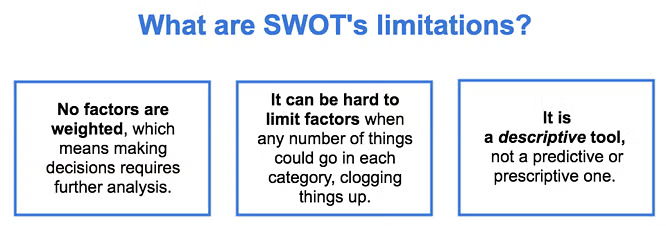Our Guide to SWOT Analysis is as detailed as it gets. Jump ahead to any section or learn how to do a SWOT analysis of your own:
Gliffy is a popular tool for diagramming and making SWOT charts. Get started with a free trial of Gliffy to make the most of this SWOT example by creating your own.
Back to top
What is SWOT Analysis?
SWOT analysis is a powerful tool for charting a high-level view of your business, feature, or an entire industry's competitive landscape. SWOT stands for strengths, weaknesses, opportunities, and threats. Strengths and weaknesses indicate “internal” factors, controlled by the makers of the decision, and opportunities and threats are “external” factors, outside of an individual or company's control.
While primarily considered a diagram for businesses, making a SWOT chart comes in handy for cases across all industries.
When you need a situational analysis of your business, the market, or a new feature idea, SWOT analysis is exactly the analytical brainstorming technique to get you started. Maybe you want to figure out a crisis remediation or a go-to-market strategy — SWOT's for that as well.
Think of it as a kind of pumped-up pro and con chart, with more features and a slicker design that helps you actually get stuff done. Best of all, a SWOT analysis can be done by anyone.
Want to jump straight to making a SWOT of your own? Get started with a template from our SWOT analysis tutorial >>
Back to top
Video Overview: What is SWOT Analysis?
Back to top
Example SWOT Analysis
Let's say you're an e-commerce app that helps people sell clothes and accessories. You're thinking about adding some sort of social feature — what would the strengths, weaknesses, opportunities and threats in pursuing this idea look like?
Strengths Analysis
Your strengths are the things you control that give you an advantage over your competitors. Maybe your app has more users than your competitors. Maybe it has the most items listed, or the best return policy. These are internal upsides that fit the "strengths" category.
Identifying Weaknesses
Your weaknesses are the things you have some control over, but that put you at a disadvantage. Maybe your app is only available in English, or only available on Android devices. There are a few bugs that your team hasn't squashed yet, so adding new features before fixing those might not be the best decision.
Spotting Opportunities
Your opportunities are things you don't control, but that you could take advantage of. These would be industry or consumer trends, like the rise of mobile e-commerce or increases in smartphone ownership. It could also be competitors exiting the space, which creates a gap your app could fill.
Understanding Threats
Your threats are the factors you don't control that could negatively affect you. Perhaps there's a new competitor that is rapidly capturing the same demographic you were just starting to get a foothold in, or your biggest international shipping route is from France to England, and England just imposed new international shipping fees. Threats often include regulations or consumer trends leading users away from your company.
Now that you've got some basics, want to jump straight to diagramming? Here's How to Do a SWOT Analysis >>
Back to top
Goals of SWOT Analysis
The goal of SWOT analysis is to help with planning and strategy. It can be used in a myriad of settings and for a myriad of projects, but is generally most effective in the early stages before a project or venture begins. Sometimes, it's done in conjunction with other research and strategy exercises such as PEST analysis.
Completing a SWOT can take many forms, but it's most common to complete a SWOT analysis in the format of a chart or a diagram. This allows you to visually compare factors side-by-side. To get started and make your own, you can sign up for a free trial of Gliffy — or read on for more tips before diving in.
Back to top
When Should You Use a SWOT Analysis?
SWOT analysis doesn't work well in every scenario; it's best for understanding the competitive environment before you make decisions or prioritize initiatives. Let's look at some of the places where it works best:
Early Brainstorming and Planning
The SWOT process is great for early stages when you're doing exploratory work to get a feel for a new venture, new feature, new strategic plan, etc. It's a great item to include in your business plan, along with other business frameworks like a business model canvas.
Problem-Solving
When there's no clear solution in sight and you're chasing your tail trying to solve a problem, doing a SWOT exercise can help you get a clear grasp of your positives and limitations to incise into what is the root of your problem. For example, you're not sure about the best marketing avenue for your app, so you might conduct an analysis for each of your options.
Prioritizing Initiatives for your Organization
The reality is that your company only has so many resources to get work done, and prioritizing can be challenging. Thankfully, a SWOT analysis, sometimes paired with a value chain analysis, can help you determine your priorities.
By understanding both the internal and external forces acting on your company, you can determine which weaknesses are most likely to harm your company competitively or which strengths you can leverage to take advantage of an opportunity. Matching your strengths and weaknesses to the opportunities and threats you identify is an important tool for understanding which actions will be most potent in your company's success.
Learning the Competitive Landscape
At its core, SWOT analysis is about understanding the competitive landscape from a birds-eye view. Even if you've got a solid plan for the next steps your business will take, no problems to solve, or nothing to brainstorm, working your way through the SWOT framework is a good way to familiarize yourself with what's happening around your organization.
Back to top
Pros and Cons of SWOT Analysis
Now that we've gone over some good use cases, let's take a quick look at what makes it an effective tool:

It's clear that these attributes align well with its best use cases of planning and overviews. The technique's rigidity and simple, but objective framework can really clarify early questions about new ventures.
To help you understand when (not) to do a SWOT, here are some of the big negatives to the framework:

Remember — every form of analysis has both a down and an upside. SWOT is a good tool, it's just not perfect for every scenario. SWOT is not a good tool when you need nitty-gritty detail. It's not going to replace more complex systems, like you would see in a postmortem analysis, because it inherently resists being a comprehensive tool for breaking down actions and processes.
When you try to nail down an exact solution to a problem or figure out what your next step is, a SWOT analysis isn't going to immediately give you enough information to take those steps on its own.
Back to top
SWOT Your Way to Success
Incorporating SWOT analysis into your planning is a great way to help clarify your planning and exploratory processes. It's quick and easy to assemble, and anyone in the company should be able to do it. As a tool, it's very accessible and provides a great framework for discussions. Sold? Check out our tutorial for how to do a SWOT analysis.
Soon, you too could be staring out at a beautiful billboard filled with ideas and analysis.

(Although hopefully you're a little more business-minded than our friends in Silicon Valley. | Source)
If you'd prefer to make your SWOT chart digitally, Gliffy is the perfect digital whiteboard to help you gather and organize your team's ideas. Learn more about our Confluence apps or get started for free.
TRY FREE


